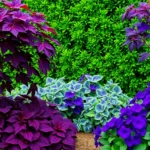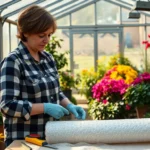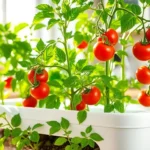Spring’s arrival brings the perfect opportunity to transform our outdoor spaces into stunning Easter displays that celebrate renewal and rebirth. We’re diving into creative garden ideas that’ll make our yards the talk of the neighborhood this Easter season.
From whimsical bunny topiaries to colorful egg-shaped planters, there’s no shortage of ways we can infuse Easter magic into our gardens. Whether we’re working with sprawling lawns or cozy container gardens, these festive decorating ideas will help us create memorable outdoor spaces that capture the joy of the season.
We’ll explore budget-friendly DIY projects alongside more elaborate installations that showcase spring blooms in delightful new ways. Get ready to discover how simple touches like pastel-colored accessories and cleverly arranged seasonal flowers can completely transform our garden spaces into Easter wonderlands that’ll have visitors stopping to admire our creative handiwork.
Create a Whimsical Easter Bunny Garden Display
Bunny themed decorations transform ordinary garden spaces into magical Easter wonderlands that capture the joy of the season. These playful elements create focal points that delight both children and adults while celebrating spring’s arrival.
Position Decorative Bunny Figurines Among Spring Flowers
Strategic placement of bunny figurines among colorful blooms creates natural vignettes throughout your garden space. We recommend clustering ceramic or resin bunnies in groups of three or five for visual impact, positioning them near daffodils, tulips, and hyacinths. Place larger figurines as anchor pieces at garden borders or pathway entrances, while smaller ones work beautifully nestled between flower stems. Weather resistant materials like stone or treated ceramic ensure your bunny collection withstands spring showers and temperature changes.
Color coordination between figurine tones and surrounding flowers enhances the overall aesthetic appeal of your display. Choose white or cream colored bunnies to complement pastel flower palettes, or select painted versions that echo exact bloom colors in your beds. Position figurines at varying heights using garden stakes or small pedestals to create depth and visual interest throughout the planted areas.
Add Bunny Shaped Topiaries or Planters
Living topiary bunnies crafted from boxwood or ivy create stunning three dimensional garden sculptures that grow more beautiful over time. Shape these green masterpieces using wire frames available at garden centers, allowing 6 to 8 weeks for full coverage to develop. Maintain the bunny silhouette with regular trimming every 2 to 3 weeks during growing season, focusing on ears and tail details that define the recognizable shape.
Bunny shaped planters offer versatile options for both permanent installations and seasonal arrangements that can be moved as needed. Fill these containers with spring favorites like pansies, primrose, or trailing petunias for cascading color effects. Large ceramic bunny planters work perfectly as statement pieces on patios or at garden entrances, while smaller versions create charming accents along walkways or grouped on outdoor tables.
Install Motion Activated Bunny Decorations
Solar powered bunny decorations with motion sensors add delightful surprises that activate when visitors approach your garden display. These battery free options typically feature gentle movements like ear wiggling or nose twitching, creating enchanting moments without requiring electrical connections. Position sensors to detect movement from main pathways, ensuring optimal activation while avoiding false triggers from swaying plants or small animals.
Interactive bunny elements equipped with sound features or LED lighting create memorable experiences that engage multiple senses throughout your garden space. Choose decorations with adjustable sensitivity settings to customize activation distance, typically ranging from 3 to 10 feet depending on your layout preferences. Weather resistant housing protects electronic components from spring moisture while maintaining reliable operation throughout the Easter season.
Design Colorful Easter Egg Hunt Gardens
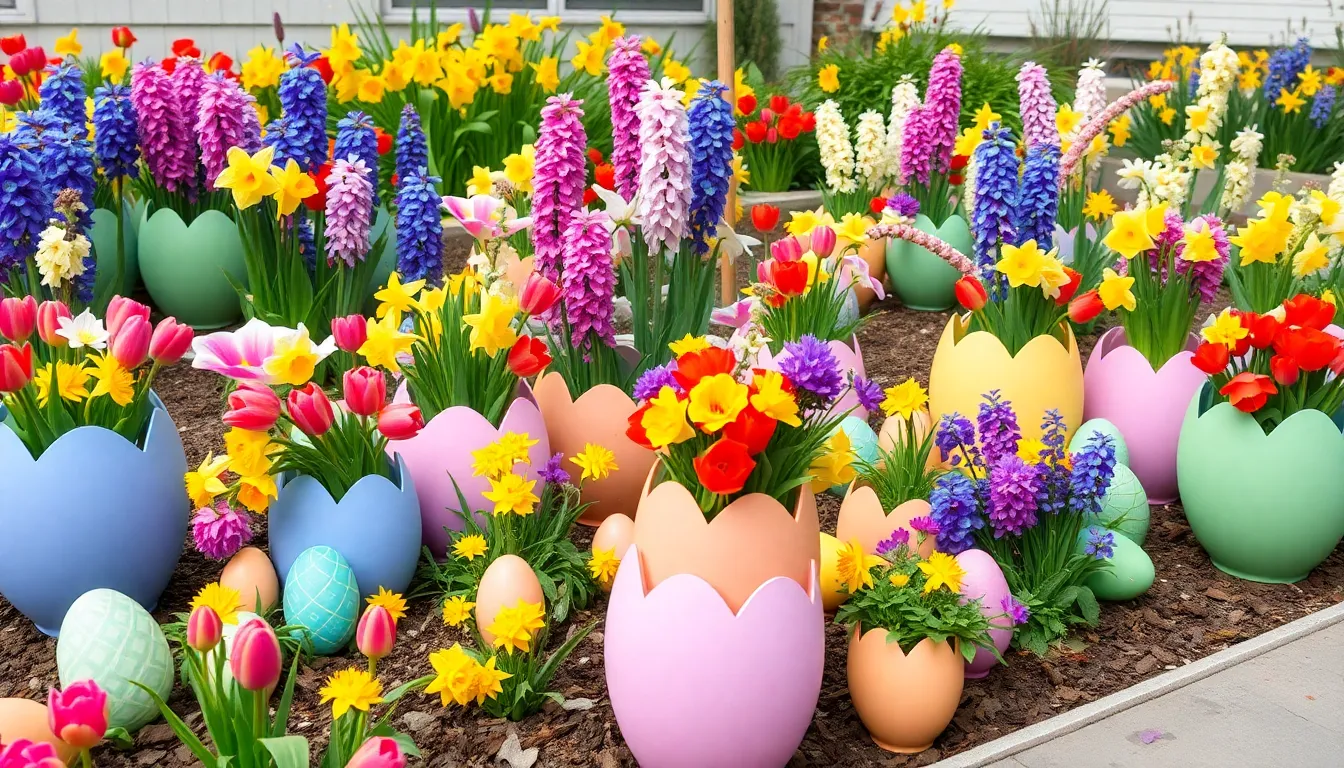
Transform your outdoor space into an interactive Easter wonderland that combines natural beauty with playful elements. We’ll show you how to create stunning garden displays that serve as both decorative features and functional hunt locations.
Plant Egg-Shaped Flowers Like Tulips and Daffodils
Tulips create the perfect foundation for our Easter egg hunt gardens with their naturally oval blooms that mirror egg shapes. Plant these spring favorites in clusters of five to seven bulbs to create substantial visual impact throughout your garden beds. Daffodils complement tulips beautifully with their bright yellow centers resembling sunny egg yolks.
Arrange these flowers in strategic patterns that mimic scattered Easter eggs across your industry. We recommend planting tulips in alternating color groups—pastel pinks next to soft purples, then bright yellows beside crisp whites. Hyacinths add vertical interest with their dense, egg-like flower clusters that release fragrant scents throughout your garden.
Crocuses work exceptionally well for smaller garden spaces or container arrangements. These petite blooms emerge early in spring and create natural carpet effects when planted in large drifts. Position different colored varieties in organic shapes rather than straight lines to simulate randomly placed Easter eggs.
Hide Decorative Easter Eggs Throughout Garden Beds
Strategic placement transforms ordinary garden spaces into exciting treasure hunt locations for visitors of all ages. We suggest hiding decorative eggs at varying heights—some nestled among low-growing flowers, others tucked beneath shrub branches, and a few placed behind garden structures.
Plastic eggs offer durability against spring weather while maintaining vibrant colors throughout the season. Choose eggs in multiple sizes ranging from small two-inch varieties to large six-inch specimens to create visual diversity. Hand-painted wooden eggs provide rustic charm and can withstand outdoor conditions when properly sealed.
Create natural hiding spots by incorporating small garden features like decorative stones, miniature bridges, or stepping stones. Position eggs partially visible rather than completely concealed to maintain the hunt’s excitement without causing frustration. We recommend using 15 to 20 eggs per 100 square feet of garden space for optimal hunting density.
Create Egg-Themed Planter Arrangements
Egg-shaped planters serve as both decorative elements and functional growing containers throughout your Easter garden display. Fill these unique vessels with spring flowers like pansies, violas, or small bulb varieties to create living Easter egg arrangements. Large plastic eggs can be repurposed into charming DIY planters by cutting openings in the top and drilling drainage holes.
Arrange multiple egg planters in groups of three or five to create focal points along garden pathways. We suggest varying the sizes and colors of your planters while maintaining a cohesive pastel color scheme. Artificial grass combined with small plastic eggs creates whimsical nest-like arrangements inside larger egg-shaped containers.
Position these themed planters at different elevations using plant stands, tree stumps, or decorative pedestals. This layered approach adds dimension to your garden while creating natural stopping points during egg hunts. Consider incorporating battery-operated LED lights inside translucent egg planters for magical evening displays that extend your garden’s appeal beyond daylight hours.
Build DIY Easter Centerpiece Garden Features
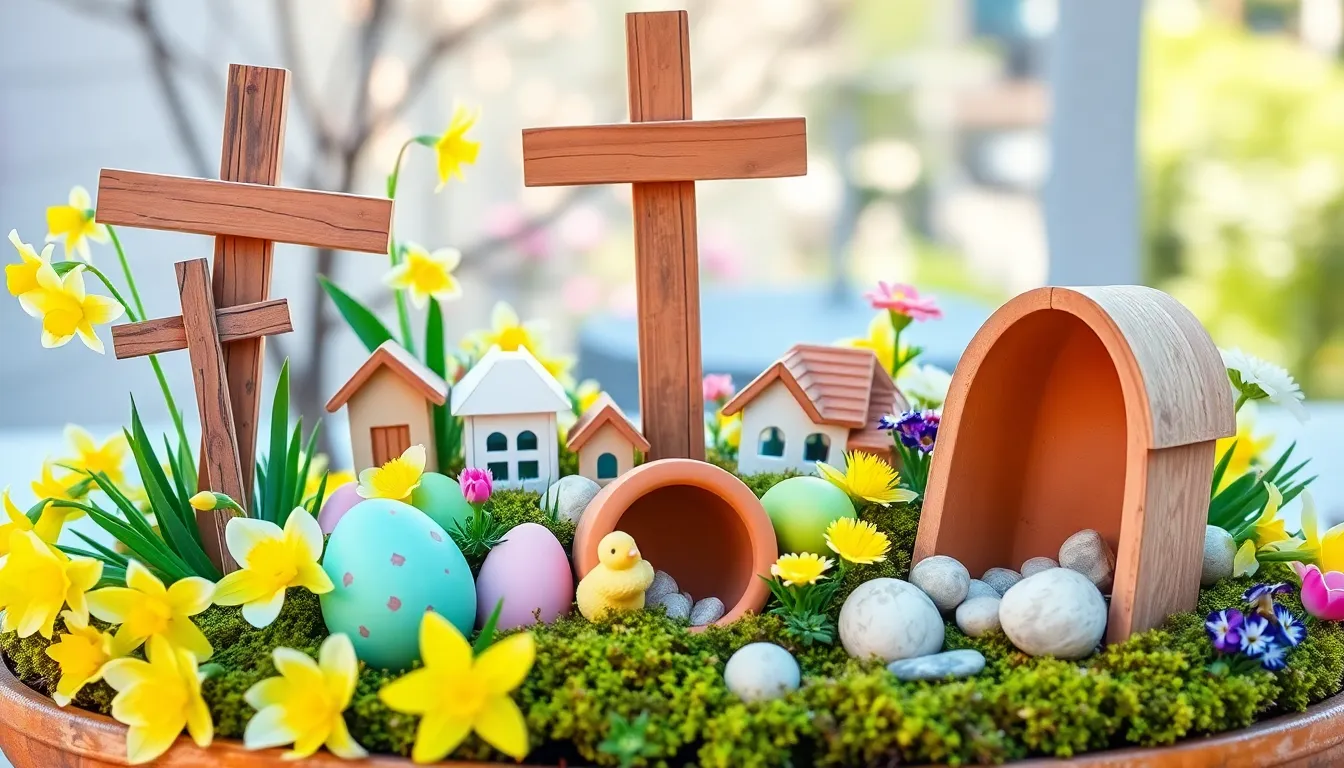
We can transform our Easter celebrations by creating stunning centerpiece garden features that bring the beauty of spring directly to our dining tables and outdoor spaces. These DIY projects combine natural elements with Easter symbolism to create memorable focal points.
Construct Rustic Wooden Cross Displays
Weathered wood serves as the perfect foundation for creating meaningful Easter cross displays that anchor our garden centerpieces. We’ll select pieces with natural aging and character marks to achieve that authentic rustic appearance. Simple designs work best for these displays, though we can enhance them with subtle carvings or rope wrapping for added texture.
Positioning becomes crucial when we place our wooden crosses in prominent spots surrounded by spring flowers like daffodils and tulips. We can create depth by varying the heights of our crosses and incorporating complementary elements such as moss covered stones or small potted plants. Natural staining or light weatherproofing helps preserve the wood while maintaining its rustic charm throughout the Easter season.
Create Miniature Easter Village Scenes
Small terracotta pots and houses form the backbone of charming miniature Easter village scenes that captivate both children and adults. We’ll arrange these tiny buildings in clusters of three to five pieces to create visual interest and natural gathering points. Different sized pots can represent various structures, from cozy cottages to small churches, each painted in soft pastel colors.
Miniature Easter themed figures like bunnies, chicks, and decorative eggs bring our villages to life when strategically placed among the buildings. We can use moss or small succulent plants to create realistic grassy areas and pathways that connect our village elements. Tiny garden accessories such as miniature benches, lampposts, or picket fences add authentic details that make our Easter villages truly enchanting.
Design Resurrection Garden Dioramas
Empty tomb representations form the centerpiece of meaningful Resurrection Garden dioramas that tell the Easter story through natural elements. We’ll use a small clay pot turned on its side within a larger saucer to create the tomb opening, filling the surrounding area with potting soil for planting. Grass seeds sprinkled throughout the soil will create a lush green carpet that symbolizes new life and renewal.
Smooth stones covering the pot opening represent the rolled away stone, while small wooden crosses placed nearby complete the sacred scene. We can enhance our dioramas with miniature flowering plants like pansies or small bulbs that bloom during Easter season. These living elements reinforce the themes of resurrection and rebirth while creating beautiful, meaningful displays that serve as conversation starters during our Easter gatherings.
Plant Spring Blooms in Easter Color Schemes
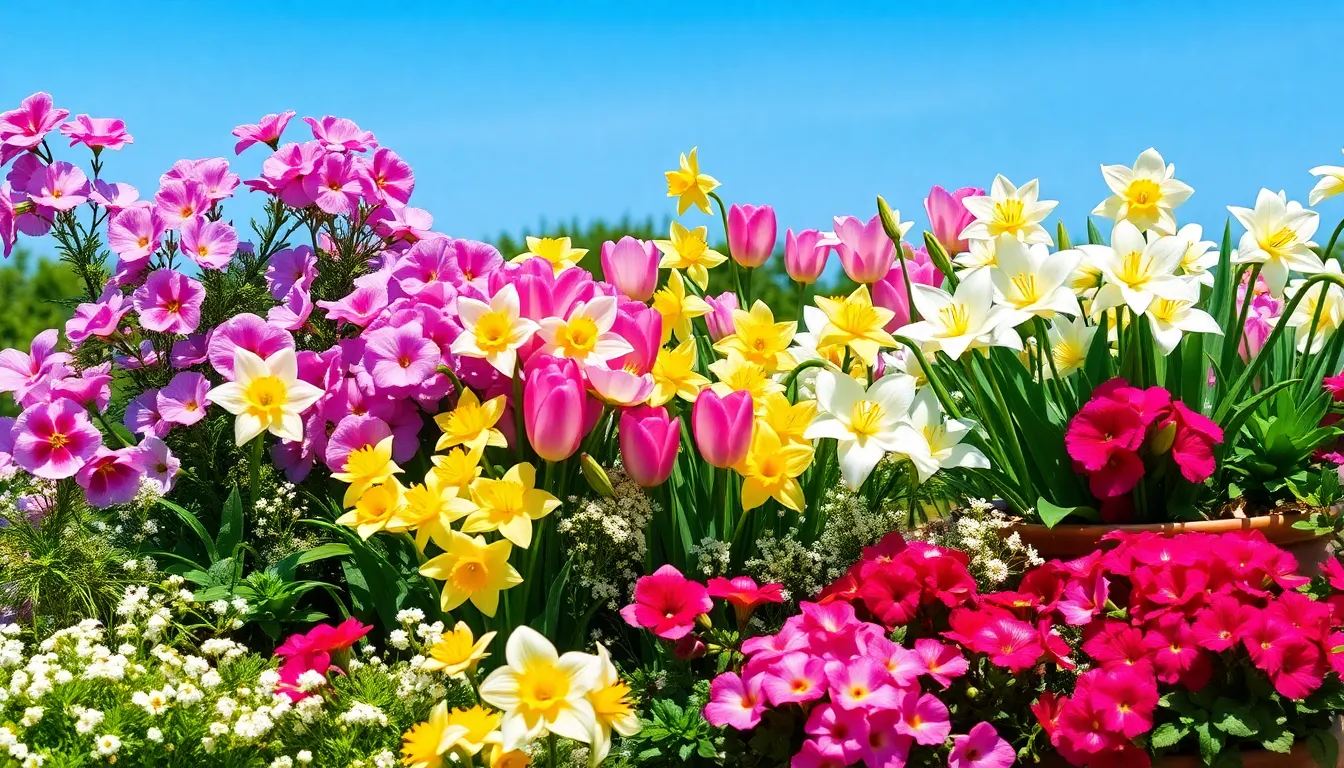
Creating stunning Easter gardens becomes effortless when we focus on the perfect color palette that captures spring’s renewal spirit.
Choose Pastel Purple, Pink, and Yellow Flowers
Pansies create the foundation for our pastel Easter garden schemes with their delicate purple and yellow faces that bloom throughout spring. We recommend planting clusters of these cheerful flowers along garden borders to establish consistent color flow. Hyacinths add fragrant purple spikes that reach 8-10 inches tall, providing vertical interest among lower plantings.
Tulips in soft pink shades offer classic Easter elegance when planted in groups of five to seven bulbs per cluster. These spring favorites bloom for 2-3 weeks, giving us extended seasonal color. Yellow daffodils complement the pastel scheme while symbolizing new beginnings and hope.
Planting these flowers together creates natural color gradients that mirror traditional Easter palettes. We suggest spacing different varieties 12-18 inches apart to allow proper growth while maintaining visual cohesion.
Arrange White Flowers for Purity Symbolism
White lilies serve as powerful symbols of purity and resurrection, making them perfect centerpiece flowers for our Easter gardens. Easter lilies specifically bloom during the holiday season, reaching heights of 3-4 feet with trumpet-shaped blooms. We position these statement flowers as focal points surrounded by lower white companions.
Baby’s breath creates delicate clouds of tiny white flowers that soften harsh garden edges and fill gaps between larger plantings. This versatile flower spreads naturally to form gentle ground cover. White tulips planted in circular patterns around garden centers reinforce themes of renewal and rebirth.
Arranging white flowers near tomb representations or cross displays amplifies their symbolic meaning. We recommend creating graduated heights with lilies in back, medium white flowers in middle, and baby’s breath cascading in front.
Mix Bright Easter Colors in Container Gardens
Container gardens allow us to create portable Easter displays using vibrant azaleas, petunias, and geraniums in traditional holiday colors. Azaleas bloom in bright pink, purple, and white, providing 4-6 weeks of continuous color when properly cared for. We select containers at least 12 inches deep to accommodate their root systems.
Petunias offer cascading varieties perfect for hanging baskets or tall planters, blooming continuously from spring through fall. These flowers come in solid Easter colors or bi-colored combinations that create visual interest. Geraniums provide sturdy upright growth with bold flower clusters in pink, red, and white.
Themed containers enhance our Easter color schemes when chosen in pastel shades or egg-shaped designs. Terra cotta pots painted in soft pastels coordinate beautifully with spring blooms. We arrange containers in groups of three or five for maximum visual impact, varying heights to create ever-changing displays.
Craft Easter-Themed Garden Pathways

Transform your walkways into enchanting Easter passages that guide visitors through your spring celebration. We’ll create magical pathways using decorative elements and lighting that enhance the natural beauty of your garden.
Line Walkways with Colorful Easter Decorations
Easter egg garlands create stunning visual impact when hung between trees or along fence lines beside your pathways. We recommend using weather-resistant plastic or fabric eggs in pastel shades that complement your existing flower color scheme.
Large Easter eggs or inflatables make bold statement pieces when placed strategically along pathway edges. Position these decorations at 6-foot intervals to create rhythm without overwhelming the natural industry.
Easter-themed garden stakes and flags add playful touches throughout your walkway design. Choose designs featuring bunnies, chicks, or inspirational messages that reinforce the renewal theme of your Easter garden display.
Create Stepping Stone Easter Egg Paths
Paint stepping stones with Easter egg designs using outdoor acrylic paints in coordinating pastel colors. We suggest creating patterns like stripes, polka dots, or floral motifs that match your garden’s overall aesthetic.
Inspirational messages transform ordinary stepping stones into meaningful pathway elements. Choose short phrases like “Hope,” “Joy,” or “New Beginnings” that resonate with Easter’s message of renewal and rebirth.
Built-in Easter-themed decorations offer durability and professional appearance when selecting pre-made stepping stones. Look for designs featuring embossed bunnies, eggs, or crosses that withstand seasonal weather changes.
Install Solar-Powered Easter Light Displays
Solar-powered string lights in pastel colors illuminate pathways beautifully during evening hours without increasing electricity costs. We recommend soft pink, lavender, and yellow LED lights that create gentle ambiance throughout your Easter garden.
Solar-powered Easter-themed decorations with built-in lighting provide functional and decorative pathway elements. Choose bunny or egg-shaped fixtures that automatically activate at dusk and provide up to 8 hours of continuous illumination.
Solar lanterns positioned at pathway curves or entrances create welcoming focal points for your Easter celebration. Select designs that complement your garden’s style while providing adequate lighting for safe navigation during evening gatherings.
Incorporate Religious Easter Garden Elements
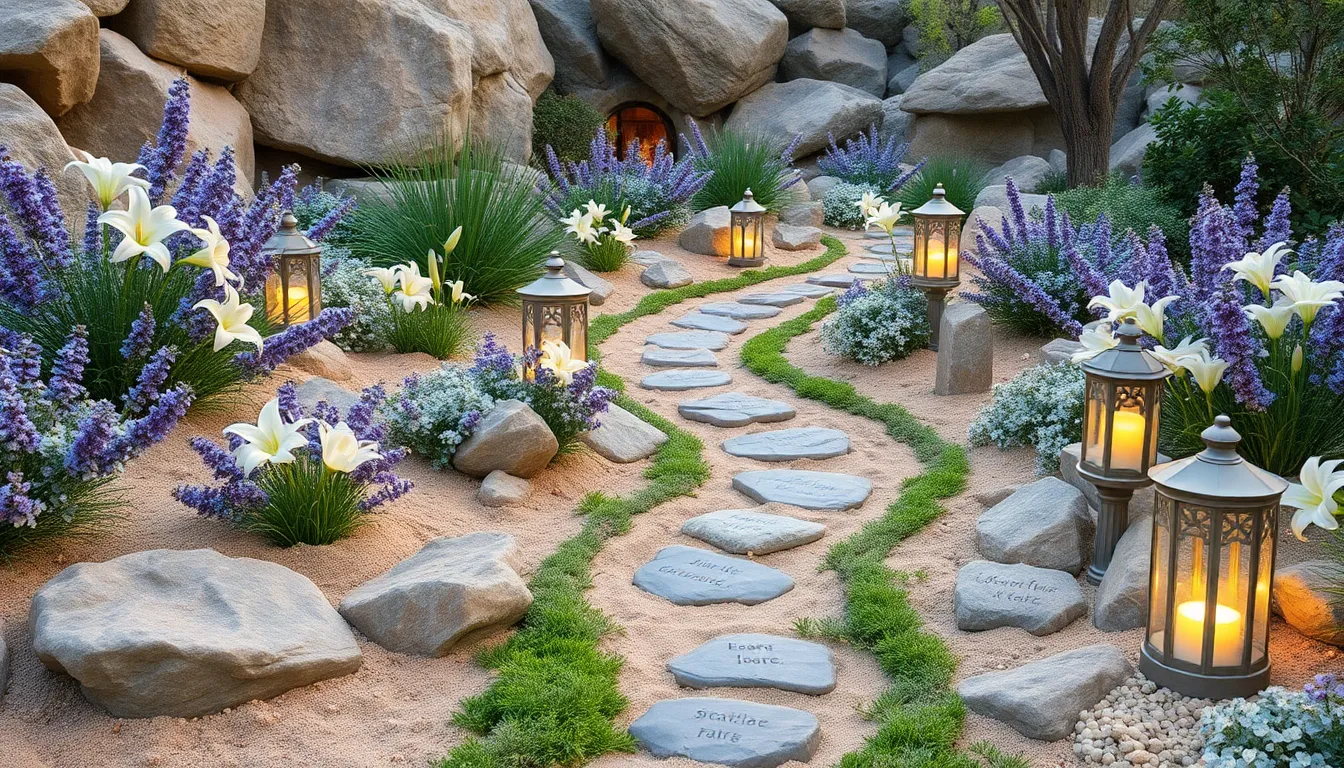
We’ll transform our Easter gardens into sacred spaces that honor the spiritual significance of this holy season. These meaningful elements help us create reflective environments where faith and nature beautifully intersect.
Design Peaceful Prayer Garden Spaces
Natural elements like rocks, sand, and small stones create the foundation for our serene prayer spaces. We arrange these materials in gentle curves and circles to establish a contemplative atmosphere that invites quiet reflection.
Meandering paths guide visitors through our prayer garden areas with intentional slowness. These winding walkways encourage meditation and provide natural pauses where we can place additional spiritual elements like crosses or scripture markers.
Soothing colors in soft pastels and earth tones enhance the peaceful ambiance of our prayer spaces. We select plants with calming hues like lavender, white Easter lilies, and pale yellow daffodils to create a harmonious backdrop for contemplation.
Soft lighting from solar powered lanterns or LED candles extends the usability of our prayer gardens into evening hours. These gentle illumination sources create a sacred atmosphere while maintaining the tranquil energy we’ve established.
Add Scripture Stones and Inspirational Signs
Biblical quotes on weathered stones bring the Easter story directly into our garden spaces. We place these scripture stones strategically along pathways and near focal points to emphasize key themes of resurrection and renewal.
Inspirational signs with messages of hope and faith serve as gentle reminders throughout our Easter garden journey. These carefully selected phrases reinforce the spiritual significance of the season while complementing our natural design elements.
Stone placement requires thoughtful consideration of both visibility and integration with existing plantings. We position our scripture stones where they’ll be easily readable yet feel naturally incorporated into the garden’s overall flow.
Weather resistant materials ensure our inspirational elements withstand spring rain and temperature changes. Engraved stone, sealed wood, and powder coated metal signs maintain their message clarity throughout the Easter season and beyond.
Create Living Nativity Scene Areas
Figurine arrangements adapted from traditional Christmas displays can tell the complete Easter story from birth to resurrection. We position these elements to create meaningful vignettes that guide visitors through Christ’s earthly journey.
Natural backdrops of evergreen shrubs and seasonal flowers provide authentic settings for our living nativity scenes. These plantings create depth and context while ensuring our displays feel integrated rather than artificially placed.
Multiple scene locations throughout our garden allow us to depict different aspects of the Easter narrative. We might feature the nativity in one area, the crucifixion in another, and the empty tomb as our garden’s triumphant finale.
Interactive elements like small benches near each scene encourage visitors to pause and reflect on each part of the story. These seating areas transform our living nativity displays into genuine prayer stations where contemplation naturally occurs.
Set Up Interactive Easter Garden Activities
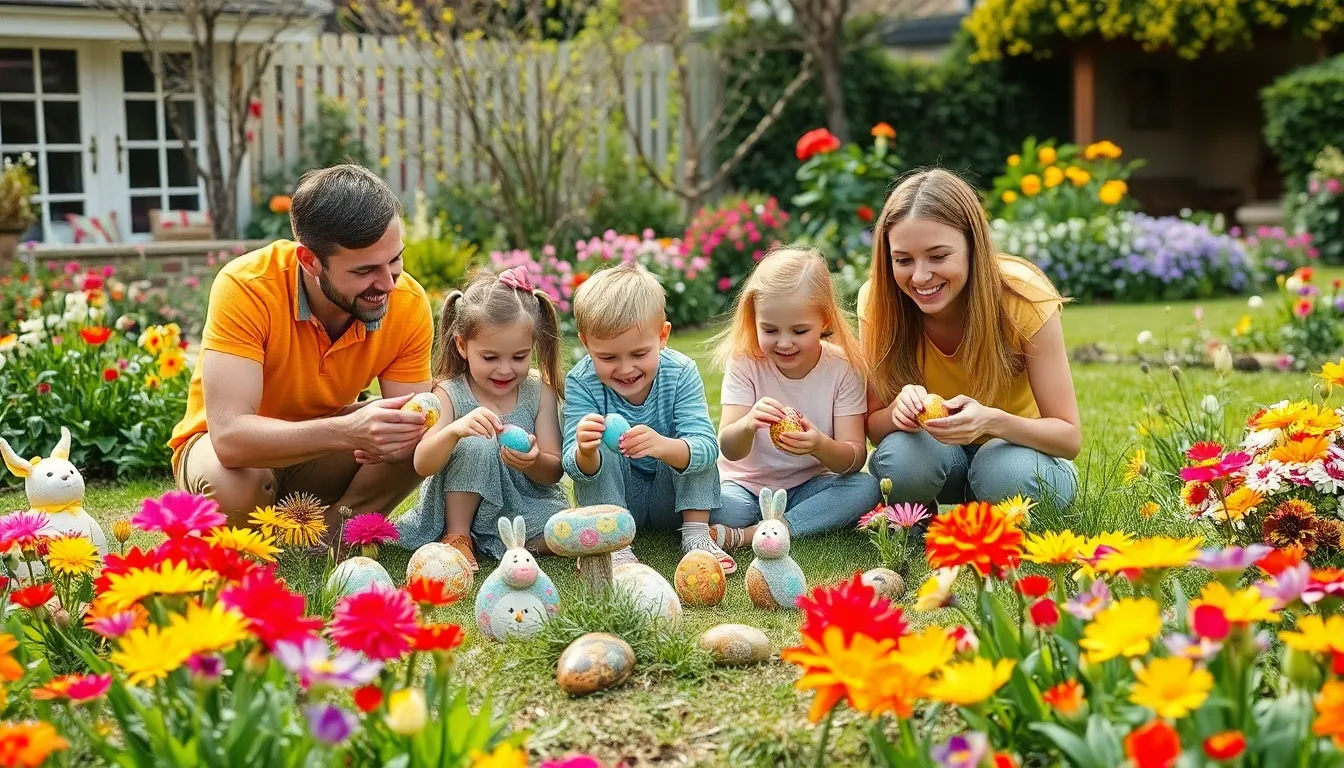
Interactive Easter garden activities transform our outdoor spaces into captivating environments where families create lasting memories together. We’ll design activities that encourage exploration while developing creativity and fine motor skills.
Install Child-Friendly Easter Scavenger Hunt Stations
Scavenger hunts captivate children by combining adventure with discovery throughout our garden spaces. We strategically place colorful painted stones and decorated eggs at designated stations to create exciting treasure hunt locations. Visual clues work better than complex riddles for younger participants, while older children enjoy solving simple puzzles that lead them to the next station.
Safety considerations guide our station placement, ensuring clear pathways and accessible hiding spots for all age groups. We design maps or picture clues that match children’s reading abilities, making the hunt inclusive and enjoyable. Each station features festive touches like wrapped pebbles or themed objects that blend naturally with our garden environment.
The hunt encourages children to observe and interact with different garden areas they might otherwise overlook. We incorporate seasonal elements by hiding eggs near spring flowers or placing stones among fresh plantings. This approach promotes garden exploration while maintaining the excitement of traditional Easter egg hunts.
Create Hands-On Planting Activities for Families
Planting activities engage families in sustainable gardening practices using creative recycled materials. We transform egg cartons and eggshells into charming miniature planters by painting them in bright spring colors. These containers work perfectly for starting seedlings or planting small flowers that families can later transplant into our main garden beds.
Children develop fine motor skills while decorating their containers with natural materials like leaves, grass, and small stones. We provide double-sided tape on cardboard egg cutouts, allowing participants to collect and arrange natural objects they discover during garden exploration. This activity promotes creativity while teaching children about different plant materials and textures.
The transplanting process becomes educational as families learn that eggshell planters can go directly into the ground, where shells naturally decompose and enrich the soil. We guide participants through proper planting techniques, ensuring their seedlings have the best chance to thrive. These hands-on experiences create connections between families and our garden spaces that extend well beyond Easter.
Design Photo Opportunity Easter Backdrops
Photo opportunities create memorable moments while showcasing our garden’s Easter transformation. We construct festive backdrops using painted pallets decorated with hanging spring flowers and large cutouts of Easter bunnies and eggs. These installations provide perfect settings for family portraits that capture the joy of our Easter celebrations.
Strategic placement of backdrops throughout the garden encourages visitors to explore different areas while creating varied photo compositions. We incorporate props like painted stones, homemade banners, and wrapped fabric elements that complement our garden’s natural beauty. These decorative touches enhance the holiday atmosphere without overwhelming the peaceful garden setting.
The backdrops serve multiple purposes by defining activity areas and creating visual anchors that guide visitors through our space. We position them near benches or open areas where families can gather comfortably for group photos. This thoughtful design approach ensures our Easter garden activities flow naturally from one area to the next, creating cohesive experiences that celebrate both the season and our outdoor spaces.
Maintain Your Easter Garden Throughout the Season
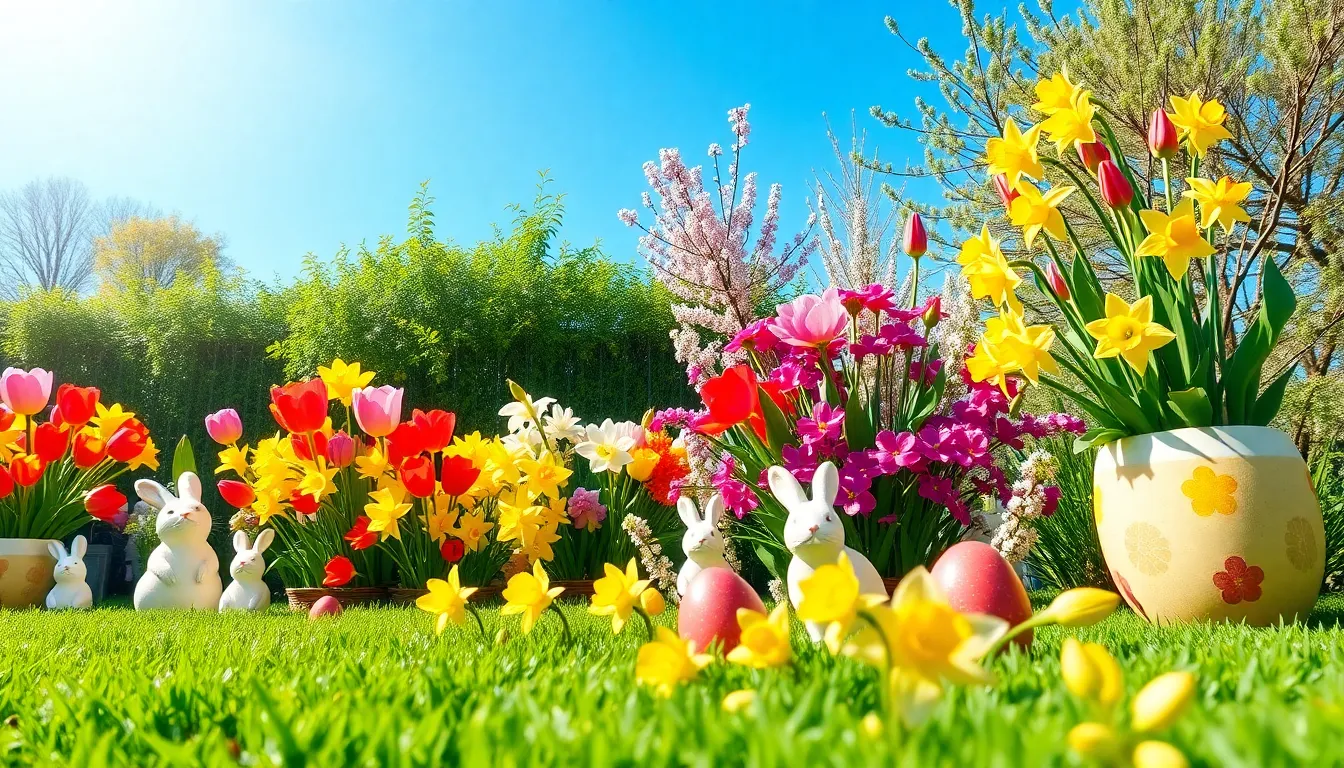
Keeping your Easter garden vibrant requires consistent care and forward-thinking strategies. We’ll guide you through essential maintenance practices that ensure your garden thrives beyond the holiday celebration.
Schedule Proper Watering and Fertilizing Routines
Establish consistent watering schedules for your Easter garden by checking soil moisture levels daily during warmer spring periods. Plants like tulips, daffodils, and Easter lilies require deep watering twice weekly rather than frequent shallow sessions.
Monitor container gardens closely since potted plants dry out faster than ground plantings. We recommend watering container displays every morning during peak growing season to maintain optimal moisture levels.
Apply organic fertilizers every three to four weeks to promote healthy growth without harming beneficial soil organisms. Compost tea and fish emulsion work exceptionally well for spring bulbs and seasonal flowers.
Feed heavy bloomers like pansies and petunias with balanced liquid fertilizer every two weeks to maintain their colorful displays throughout the season. This approach keeps your Easter garden decorations looking fresh and vibrant.
Plan for Post-Easter Transition to Summer Gardens
Prepare soil amendments by adding fresh topsoil and organic mulch to garden beds in late April. This foundation supports the transition from cool-season Easter plants to warm-weather varieties.
Plant cool-season vegetables like carrots and potatoes during early spring while maintaining your Easter display. These crops establish strong root systems before summer heat arrives.
Schedule warm-season plantings of tomatoes and peppers for after the last frost date in your area. We suggest preparing designated spaces while preserving key Easter garden elements through May.
Preserve perennial Easter plants by deadheading spent blooms and allowing foliage to die back naturally. Bulbs like tulips and daffodils need this energy storage period for next year’s display.
Transition container displays by gradually replacing Easter-themed plantings with heat-tolerant options like geraniums and marigolds. This method extends your garden’s appeal through summer months.
Store Reusable Easter Decorations Safely
Clean decorative elements thoroughly before storage by removing dirt, moisture, and plant debris from bunny figurines and egg-shaped planters. Proper cleaning prevents mold and deterioration during off-season storage.
Dry all items completely in a well-ventilated area for 24 to 48 hours before packing. We’ve found that moisture trapped in storage containers causes important damage to Easter garden decorations.
Use protective coverings like bubble wrap or soft cloth bags for delicate items such as ceramic bunnies and glass ornaments. Label each container with contents and storage date for easy identification next spring.
Store in climate-controlled spaces away from extreme temperatures and humidity fluctuations. Basements and attics often create damaging conditions for garden decorations over extended periods.
Organize seasonal containers by grouping similar items together and creating an inventory list. This system streamlines setup for next year’s Easter garden display and prevents loss of valuable decorative pieces.
Conclusion
We’ve explored countless ways to transform your outdoor space into an enchanting Easter celebration that brings joy to family and friends. From budget-friendly DIY projects to elaborate garden designs these ideas offer something for every skill level and garden size.
The beauty of Easter gardens lies in their ability to blend natural spring elements with meaningful symbolism creating spaces that nurture both the soul and the senses. Whether you’re crafting miniature village scenes or designing interactive pathways each element contributes to a cohesive celebration of renewal.
Remember that your Easter garden doesn’t have to end when the holiday passes. With proper maintenance and thoughtful transitions many of these features can evolve into beautiful summer displays ensuring your investment in time and creativity continues to pay dividends throughout the growing season.
Start planning your Easter garden transformation today and watch as your outdoor space becomes a beacon of hope and celebration that welcomes spring with open arms.
Frequently Asked Questions
What are some budget-friendly DIY Easter garden decoration ideas?
Create whimsical displays using painted stones, recycled egg cartons as planters, and homemade bunny figurines. Transform terracotta pots into Easter-themed containers with pastel paint. Make stepping stones with Easter egg designs, craft rustic wooden crosses from weathered wood, and use eggshells as biodegradable seed starters for children’s planting activities.
Which flowers work best for Easter garden color schemes?
Plant pastel-colored flowers like purple pansies, pink tulips, yellow daffodils, and white hyacinths for a cohesive Easter palette. Easter lilies and baby’s breath add symbolic white elements representing purity and resurrection. For container gardens, use bright azaleas, petunias, and geraniums to create vibrant, portable displays that complement the Easter theme.
How can I create an interactive Easter egg hunt in my garden?
Hide decorative eggs at varying heights throughout garden beds and among spring flowers. Plant egg-shaped flowers like tulips in clusters to mimic scattered Easter eggs. Use egg-themed planters and create treasure hunt stations with colorful painted stones. Add lighting for evening displays and incorporate motion-activated decorations for extra excitement.
What are effective ways to incorporate bunny decorations in gardens?
Place decorative bunny figurines in clusters of three to five among spring flowers for visual impact. Use bunny-shaped topiaries and planters filled with vibrant blooms. Consider motion-activated bunny decorations with solar power for interactive elements. Strategically position them to create natural vignettes that delight both children and adults visiting your garden.
How do I maintain my Easter garden beyond the holiday season?
Establish consistent watering routines and use organic fertilizers to keep plants healthy. Transition Easter displays to summer gardens by amending soil and following proper planting schedules. Store reusable decorations safely in dry locations. Continue caring for perennial flowers and consider replanting seasonal blooms to maintain garden beauty year-round.
Can I create religious Easter garden elements?
Design peaceful prayer garden areas using natural materials and soothing colors for reflection spaces. Add scripture stones and inspirational signs throughout the garden. Create Resurrection Garden dioramas with symbolic elements like empty tombs made from stones. Incorporate living nativity scenes and meaningful vignettes that honor the spiritual significance of Easter.
What lighting options work best for Easter garden displays?
Use solar-powered lights in pastel colors to illuminate pathways and highlight key features. Install themed decorations with built-in lighting for evening displays. Consider string lights in Easter egg shapes or bunny designs. Motion-activated lighting adds interactive elements while providing safety for evening gatherings and extending the garden’s visual appeal after dark.
How can I make my Easter garden child-friendly and educational?
Set up scavenger hunt stations with painted stones and safe decorative elements. Create hands-on planting activities using recycled egg cartons and eggshells as biodegradable planters. Design photo opportunity backdrops and ensure all decorations are safely positioned. Include interactive elements like motion-activated features while teaching children about gardening and plant care.























